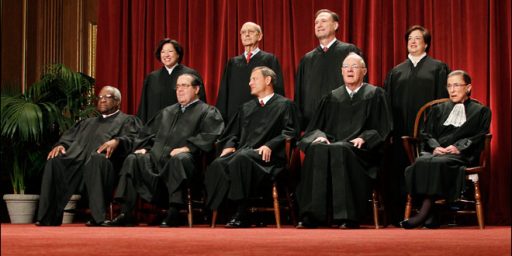Supreme Court To Try To Draw Line Between Free Speech Online And Criminal Threats
Next week, the Supreme Court will be asked to determine the line between free speech online and criminal threats
On Monday morning, the Justices of the Supreme Court will jump right back into work with a hearing in a case involving an estranged husband and wife, Facebook, and the question of when a post made on a social media network like Facebook that would ordinarily clearly be protected by the First Amendment crosses the line into an illegal threat:
About a week after Tara Elonis persuaded a judge to issue a protective order against her estranged husband, Anthony, her soon-to-be ex had this to say:
“Fold up your PFA [protection-from-abuse order] and put it in your pocket
Is it thick enough to stop a bullet?”
Anthony Elonis didn’t deliver the message in person, by phone or in a note. Instead, he posted it on his Facebook page, for all to see, in a prose style reminiscent of the violent, misogynistic lyrics of rap artists he admired.
In its first examination of the limits of free speech on social media, the Supreme Court will consider next week whether, as a jury concluded, Elonis’s postings constituted a “true threat” to his wife and others.
The issue is whether Elonis should be prosecuted for what he says was simply blowing off steam — “therapeutic efforts to address traumatic events,” as his brief to the court says — because what matters is not his intent but whether any reasonable person targeted in the rants would regard them as menacing warnings.
Parties on both sides of the groundbreaking case are asking the court to consider the unique qualities of social media. In this rapidly evolving realm of communication, only the occasional emoticon may signal whether a writer is engaging in satire or black humor, exercising poetic license, or delivering the kind of grim warnings that have presaged school shootings and other acts of mass violence.
Elonis, who has served prison time for his Facebook posts, and some of his supporters say the court must look beyond incendiary content to discern the writer’s intent.
“Internet users may give vent to emotions on which they have no intention of acting, memorializing expressions of momentary anger or exasperation that once were communicated face-to-face among friends and dissipated harmlessly,” said a brief filed on Elonis’s behalf by the Student Press Law Center, the Electronic Frontier Foundation and the writers organization PEN.
Domestic violence experts, on the other hand, say social media has become a powerful tool for dispensing threats.
Victims of domestic abuse, according to a brief filed by the National Network to End Domestic Violence, “have experienced real-life terror caused by increasingly graphic and public posts to Facebook and other social media sites — terror that is exacerbated precisely because abusers now harness the power of technology, ‘enabling them to reach their victims’ everyday lives at the click of a mouse or the touch of a screen.'”
The case carries wide First Amendment implications for free-speech rights and artistic expression. Briefs laden with the f-word and vulgar references to the female anatomy attempt to provide a crash course on Eminem and Wu-Tang Clan for the justices, whose tastes lean more toward Wagner and Puccini, and illuminate what some scholars say are the misunderstood storytelling attributes of rap.
It is a thoroughly modern case for justices who even eschew e-mail communications with one another but are increasingly called upon to decide issues centered on evolving technology. Last term alone, they decided cases involving cellphone privacy, software patents and cloud-based Internet streaming video.
SCOTUSBlog’s Amy Howe previews the legal issues involved in the case:
In the fall of 2010, Elonis’s Facebook posts included several that discussed harming his ex-wife. One post was a take-off on a comedy routine available on YouTube: Elonis asked his Facebook friends whether they knew that it was illegal for him to say that he wanted to kill his ex-wife, and he added that it would be “incredibly illegal” to suggest that someone could kill his ex-wife by firing a mortar launcher from the cornfield behind her house. A day later, Elonis put up a post about shooting a kindergarten class.
These posts earned Elonis a visit from an FBI agent. After the visit, he posted about that encounter too, suggesting in rap lyrics that he had strapped a bomb to his body and would have detonated it if he had been arrested. This post was apparently the last straw for the FBI: a few weeks later, Elonis was arrested and charged with violating 18 U.S.C. § 875(c), which makes it a crime to communicate threats in interstate commerce – for example, over the Internet.
Elonis claimed that the charges against him should be dismissed because you can only violate the law if you intend to threaten someone. And he didn’t have any plans to threaten his ex-wife, the FBI agent, or anyone else: his rap lyrics and “venting” about his problems on Facebook just made him feel better. But if he can be convicted without any intent to threaten anyone, he added, that would violate the First Amendment. A federal trial court rejected both of his arguments. Instead, it instructed the jury, it could find Elonis guilty if the average person, looking at a statement objectively, would believe that it was intended to be a threat. The jury convicted Elonis, and he was sentenced to nearly four years in prison.
As Elonis emphasized in his Facebook posts, the First Amendment protects a right to free speech. But that right is not unlimited; the classic example is that you can’t shout “Fire!” in a crowded movie theater when there is actually no fire, because the resulting chaos could lead to injuries or even death. The Supreme Court has held that the First Amendment also does not protect “true threats,” but it has not specifically said how courts should decide what is (or is not) a “true threat. This case could give it that opportunity.
In his briefs at the Supreme Court, Elonis argues that a “threat” by its very nature requires an intent to cause fear. Because the whole point of a crime, he says, is that the defendant meant to do something wrong, the Court has interpreted criminal laws as requiring a wrongful intent even when they did not explicitly do so. Making it a crime to threaten someone even if you didn’t intend to threaten them, he contends, would cause people not to speak at all, because they would be worried about whether they could go to jail based on a jury’s possible misinterpretation of their comments. This is particularly true, he concludes, when you are talking about alleged threats on social media and email, where nuance and tone matter so much and it’s so easy to misconstrue what someone says.
The federal government counters that, as the trial court in this case instructed the jury, courts should determine whether something is a “true threat” by looking at whether an average person would interpret the statement as reflecting a serious intent to harm someone. The government emphasizes that courts and juries can and should look at the context in which the alleged threat was made, and at the reactions of the people who heard the alleged threat, but they should not consider whether the defendant himself actually intended to threaten. This, the government explains, is because even if Elonis didn’t intend to threaten his ex-wife or the FBI agent, they were still afraid and their lives were still disrupted: the First Amendment doesn’t protect him even if he knew that he didn’t mean to threaten them.
Emily Bazelon also profiles this case in a piece that was published last weekend in The New York Times Magazine. As she points out, and as Amy Howe notes in the piece linked above, is what comes down to the primary issue in this case. Elons argues that he should not be prosecuted for what he posted on his Facebook page because, instead of actually being a threat, it was, in essence, a form of therapy. What appear to be violent threats against his estranged wife is, in reality, playacting of the kind that people often engage in online. Since there was never any intent on his part to threaten anyone via his postings, he cannot be prosecuted for what he posted. The obvious problem in dealing with a defense such as this, of course, is that it is quite easy for a Defendant to say after the fact that they never actually intended to threaten anyone. At that point, it becomes a question for a jury. In Elonis’s case the jury was instructed that they could find him guilty if they believed that it was reasonable for his estranged wife to view the posts a serious threat to cause her harm. The question before the Court on Monday will be whether this was the proper instruction, or whether the jury should have been instructed that it could only convict if it believed that Elonis truly intended to harm her and that it must acquit if there was any reasonable doubt on this issue. Obviously, if the Court adopts some version of the standard that the Defendant wants then it would make it much harder for prosecutors at all levels to convict someone who made what a potential target might perceive to be a threat against him or her, especially in an online forum where things such as anonymity, a sense of role-playing and people taking on personas that are different from those they project in the “real” world, and openness have long been hallmarks.
As with many cases that involve important Constitutional issues like Freedom of Speech that make it all the way to the Supreme Court, it’s difficult to see what the right answer to the balancing test the Justices will be required to perform here might be. On the one hand, it has long been true under the Court’s precedents that true threats to cause bodily harm are not entitled to First Amendment protection. This exception to the Amendment makes sense if only because it’s hard to see how “freedom of speech” was ever intended to protect someone who was walking around threatening to harm or kill people, especially given the fact that people who make such threats often end up finding a way to carry them out, at which point the government needs to worry about punishing them for something far more serious than just making a threat. At the same time, though, it cannot be said that speech that amounts to “blowing off steam” or engaging in fantasy is something that isn’t entitled to First Amendment protection, not the least because it then becomes hard to easily draw a line between people who are actually causing harm to someone and those who are engaging in what amounts to fantasy. This is last caveat is why the Supreme Court has often come down on the side of the First Amendment in cases involving shocking and offensive speech such as the Westboro Baptist Church’s funeral protests, a 2001 Federal law banning depictions of ‘animal cruelty,’ and 1996 law banning virtual depictions of child pornography that did not involve actual children in production, which the Court struck down as unconstitutional.
Based on these, and other recent Supreme Court cases in the First Amendment area, my suspicion is that the Justices would be inclined to rule in Elonis’s favor. However, there is an obvious risk in adopting the standard that conviction that he argues for here. For one thing, it would make prosecuting almost any “true threat” case virtually impossible. In order to proceed, a prosecutor would have to have at least some reasonable belief that they could prove beyond a reasonable doubt that the Defendant actually intended to make actual threats in the online posts that would be at issue in a particular case. Inevitably, that is going to mean that actual threats may go unpunished and may descend into violence, especially in the domestic sphere. For that reason, I suspect that the oral arguments in this case will find the Justices probing the attorneys for both sides for some kind of a middle ground between the two positions. Whether they can find one or not is an open question, but this will be an interesting case to watch unfold, so I’ll likely have more to say about this after the Court has heard the case. As things stand right now, though, I’d have to say that, especially before this Court, Elonis likely has the best chance of succeeding in his argument.
For those interested, you can find the various briefs in this case at SCOTUSBlog’s information page for the case.





It seems to me two clear factors here — possibly necessary and sufficient conditions — are that the threats be aimed at a recognizable individual who can be expected to receive the message. The reference to the PFA in the example quoted here uniquely identifies both the victim and the crime being contemplated; posting it on his Facebook page makes it likely that she would see it. Of course it’s a threat. It would not have been a threat if he had either not aimed it at a distinguishable individual, or if he’d written it on a post-it note and stuck it inside his desk drawer.
it’s my perception that free speech is specifically directed toward political speech. Now, unless you can verify for me that threats against an ex wife, constitute political speech……
No, free speech is not limited to political speech.
Congress shall make no law abridging freedom of speech or the press.
In point of fact, Congress has made a whole bunch of laws doing just that. See: the FCC. But in theory, no, we cannot place limits on free speech. But we can pass laws against threatening someone’s life.
so I can threaten to kill you without any recompense?
(Example only, of course)
@Eric Florack:
Be sure to let us know when you return from whatever alternate reality you inhabit.
@Eric Florack:
No, Eric, that’s the question, isn’t it?
None of the cases Mr. Mataconis brings up at the end, to suggest the court will favor the free speech argument, deal with anything that can be construed as a threat against a specific person, so I wouldn’t be so sure that the court will rule in favor of the creepy, threatening, asshole defendant.
Also, I’m not sure the fact that he used the internet matters that much,beyond the question of whether the ex-wife is likely to see or hear about the threats.
Would the defendant’s threatening statements be ok if he was standing in front of her house two feet past the restraining order, carrying a sign or shouting through a megaphone? (Let’s assume he is not simultaneously exercising his second amendment rights to open carry…) I would expect he would be arrested.
If he were at a bar, two towns over, getting drunk and complaining to his friends, I think he would likely be on more solid ground, as there is no reason to believe that the ex-wife would even know about the threatening statements, and mouthing off drunk in a bar is a time honored American tradition.
@anjin-san: My perception has always been that the courts give political speech a lot more leeway than nonpolical speech, not to the extent that there is no protection of nonpolical speech, but that it is a factor.
That said, it is a crime to threaten the President, which would be the most political version of threatening speech, so the political nature is only one factor.
@Gustopher:
Florack said “specifically” – words mean things.
I don’t get the point of death threats. Death isn’t scary. Death is the end of fear. Now, crippling someone, that’s scary. Severing a spinal cord, or disfiguring, or framing someone so they end up in the joint, that’s all scary. A radioactive substance introduced into your environment so that by the time you’ve already got the tumors before you even get a hint at the cause, that’s good. Low-dose hallucinogens over a protracted period of time, get the person forcibly committed.
People need more imagination.
“I don’t get the point of death threats. Death isn’t scary. Death is the end of fear. ”
You don’t get anything right. It isnt about fear. It’s about doing what needs to be done, when it needs to be done. You just do that thing, and nobody knows who done it, and the guy dint know what was comin.
@michael reynolds:
Be grateful that’s how you see it. For me, it’s Larkin’s Aubade.
I work all day, and get half-drunk at night.
Waking at four to soundless dark, I stare.
In time the curtain-edges will grow light.
Till then I see what’s really always there:
Unresting death, a whole day nearer now,
Making all thought impossible but how
And where and when I shall myself die.
Arid interrogation: yet the dread
Of dying, and being dead,
Flashes afresh to hold and horrify.
The mind blanks at the glare. Not in remorse
—The good not done, the love not given, time
Torn off unused—nor wretchedly because
An only life can take so long to climb
Clear of its wrong beginnings, and may never;
But at the total emptiness for ever,
The sure extinction that we travel to
And shall be lost in always. Not to be here,
Not to be anywhere,
And soon; nothing more terrible, nothing more true.
This is a special way of being afraid
No trick dispels. Religion used to try,
That vast moth-eaten musical brocade
Created to pretend we never die,
And specious stuff that says No rational being
Can fear a thing it will not feel, not seeing
That this is what we fear—no sight, no sound,
No touch or taste or smell, nothing to think with,
Nothing to love or link with,
The anaesthetic from which none come round.
And so it stays just on the edge of vision,
A small unfocused blur, a standing chill
That slows each impulse down to indecision.
Most things may never happen: this one will,
And realisation of it rages out
In furnace-fear when we are caught without
People or drink. Courage is no good:
It means not scaring others. Being brave
Lets no one off the grave.
Death is no different whined at than withstood.
Slowly light strengthens, and the room takes shape.
It stands plain as a wardrobe, what we know,
Have always known, know that we can’t escape,
Yet can’t accept. One side will have to go.
Meanwhile telephones crouch, getting ready to ring
In locked-up offices, and all the uncaring
Intricate rented world begins to rouse.
The sky is white as clay, with no sun.
Work has to be done.
Postmen like doctors go from house to house.
“Therapuetic action, play acting, blowing off steam”: b.s.
Seems to me the obvious middle ground is to make recklessness the required mens rea. If the defendant engaged in conduct that a reasonable person would perceive as threatening and did so with a reckless disregard for whether it would be received by the victim and/or cause the victim to be placed in fear, then that constitutes a “true threat” that is outside the protection of the First Amendment. Making threatening statements while sitting around with some friends in your living room = blowing off steam. Standing on the street near the target’s house and making the same statements on a megaphone = true threat. Making the statements on social media = depends on the public or private nature of the social media and the steps you take to maintain privacy if such privacy settings are available. Password-protected, limited membership forum post = not reckless and thus blowing off steam. Public Twitter post = reckless and thus a true threat. Facebook wall post = maybe depends on your settings and whether you and the target have any shared friends, but I’m inclined to say it’s reckless and thus a true threat in most cases.
@Eric Florack: Maybe not from the government (though that, as Reynold’s notes, is the question before the court), but, and I can only speak for me, I would never threaten anyone unless I was up for whatever recompense they might feel would be appropriate to the situation.
How about you? You sound like a tough guy a lot around here. Do you believe that you can threaten people without recompense?